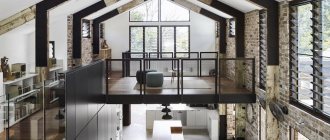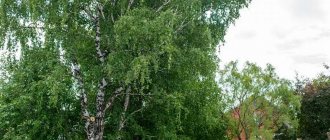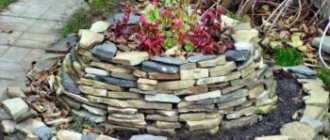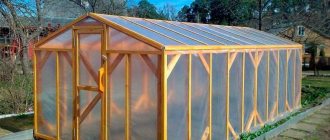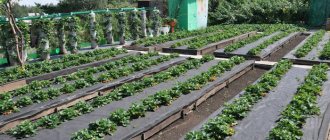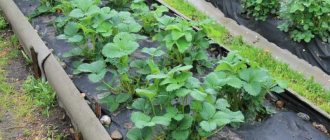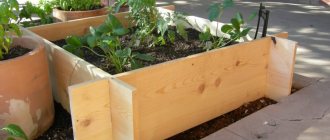Every summer resident would like to receive a rich harvest of strawberries in the shortest possible time. And enterprising Finns are no exception. They had to invent a method for accelerated ripening of strawberries not because life was good: summer in Finland is short and not very warm.
But the Finnish method involves more than just heat preservation. Among its advantages is the ability to get clean berries, without weeds. It is this growing technology that ensures that the crop is inaccessible to pests and also significantly reduces the likelihood of diseases in plants. Due to the fact that the top part is placed on the covering material, the strawberry tendrils cannot take root. Well, the above method ensures a minimum of labor and effort when weeding.
If a few years ago this method seemed something exotic to novice summer residents, today, in principle, any gardener can grow strawberries using Finnish technology.
How to choose a site for planting
When growing strawberries in open ground, it is necessary to take into account that they do not bear fruit well in the shade. Strawberry beds should be planted in sunny south-eastern areas of the garden. The place for planting strawberries should be well protected from the wind. The beds can be placed between blackcurrants and gooseberries.
A bountiful harvest can be obtained by planting strawberries in light soil that allows water and air to pass through well and has a low acidity level (5-6 pH). Garden strawberries grow well both on a sandy substrate enriched with humus and in humus or turf soil. Waterlogged, saline and calcareous soils are not suitable for strawberries.
You can grow this crop on sandy-loamy soil, but in such dense soil it is necessary to add raising agents. For these purposes, rotted sawdust mixed with ash is used. Soaking 10 kg of sawdust for 2 hours in the following solution will help speed up the process of softening wood:
- 2 liters of water;
- 2 tbsp. urea.
Peat absorbs and retains moisture well, but its use as a leavening agent is not recommended because it increases the acidity of the soil. To compensate, ash or dolomite flour is added to the peat. Adding loosening agents containing ash to the soil is only permissible in the autumn, because it contains a lot of calcium. This element can negatively affect the growth and development of plants. To loosen the soil in spring, coarse river sand-perlite is used.
When growing strawberries for more than three years in the same area, the berries will become small and the plant will develop worse. This is due to soil depletion. To restore its composition, it is recommended to practice the order of growing garden crops.
In order for the substrate to have the most suitable composition for planting strawberries, you need to select those areas where legumes or cereals grew. The best predecessors of strawberries are the following plants: carrots, corn, radishes, parsley, dill or celery.
It is undesirable to place strawberry beds in places where vegetables grew: cucumbers, eggplants, tomatoes, peppers, cabbage or potatoes. These plants can leave behind fungal spores, viruses, bacteria and insect larvae in the soil, which can destroy the strawberry plantation.
Strawberries are a delicate plant, so they are susceptible to various infections. When growing garden strawberries on a plot of turf, you must first disinfect the soil. This procedure is carried out in early spring immediately after the snow melts. In order to get rid of weed seeds, fungal spores and insect larvae, use ammonia water (1 liter per 5 sq.m.) or Roundup.
Advantages and disadvantages
Why is Finnish technology gaining popularity?
It has a number of undeniable “ advantages ”:
- in high ridges the soil warms up better;
- under the film, in the top layer of soil, a large number of useful nutrients necessary for the growth and ripening of berries accumulate;
- simplification of agricultural technology;
- plants are less affected by infections and pests;
- arrangement of drip systems ensures standardized irrigation;
- the berries on the film or cloth are clean, without traces of dirt;
- The beds look neat, there are no weeds.
You can grow berries on film both in greenhouses and in open-air areas. The technology is applicable to any area and is especially in demand by farmers who grow produce for sale.
Among the “ disadvantages ” they note the need to purchase a large amount of canvas (film). But if you follow the rules and techniques of agricultural technology, the costs will pay off pretty quickly. Also, when growing on film, propagation of plants by tendrils becomes more difficult.
Under normal conditions, rosettes of lateral shoots (if they are left for propagation) take root directly into the ground. When using film, you will have to place pots or cups for rooting. In general, the method deserves attention and is recommended for those summer residents who like to experiment.
Optimal bed sizes
Strawberries can be grown in open ground in several ways: in a carpet, in rows or in nests. Each of them has its own advantages and disadvantages.
When growing garden strawberries using the carpet method, the gardener does not need to make special efforts to maintain the plantation in good condition: it does not require frequent watering, fertilizers and weeding. The size of such a strawberry field is not limited. The strawberry grows, releasing shoots on which new rosettes are formed. Thus, the plant covers the area with a dense layer of living “carpet”, which creates its own microclimate and mulches the soil.
A significant disadvantage of this method is that with an uncontrolled increase in the number of rosettes, the strawberries begin to become smaller.
Growing in beds allows you to get a harvest with larger berries and protect the roots from rotting with additional drainage furrows between the rows. For better drainage of sedimentary waters, the plantation is set up on a small hill.
The width of the bed is 20 cm, and the furrows between the rows are 40 cm. In this case, the distance between strawberry bushes should be at least 30 cm. Planting plants more densely leads to crushing of the berries. The difference between the level of the bed and the furrow is 25 cm. Thus, the plantings are located on a small hill, which guarantees good drainage. It is advisable to direct the rows from east to west. This arrangement of strawberries will ensure uniform lighting throughout the day.
Hanging beds are used to grow strawberries in nests.
Features of the technology
An interesting idea is based on the use of film or agrofibre, which retains heat in the soil. They are usually used for shelters, but in this case they are used as mulch. In addition, they make high beds for strawberries and install drip irrigation systems. Taken together, this set allows you to accelerate the growth, development and ripening of berries, and increase productivity.
With a short summer season at temperate latitudes, it is usually possible to grow early-ripening crop varieties. The method with high beds and film (or non-woven material) is an opportunity to plant any varieties, including those with neutral daylight hours.
Short-day strawberries produce a crop once, at the beginning of summer. Varieties of long and neutral daylight hours bear fruit 2-3 times per season or in “waves,” with short pauses for the formation of generative buds. By using mulching film, gardeners get a harvest much faster, while requiring less hassle when caring for plants.
The method of planting on film in high ridges was appreciated by many summer residents. And now the Finnish method is used not only on farms, but also on private plots in various regions of Russia.
What can you plant next to strawberries?
It is recommended to plant root parsley next to garden strawberries. If sown between strawberry bushes, it will help repel slugs and snails. Strawberries and carrots go well together in one planting, but you will have to give up parsley.
Beets, radishes and radishes are also planted next to strawberries. For joint planting, choose plants that are harvested at the same time as strawberries. Radishes grow well in row spaces. To do this, the furrows between the rows must be at least half a meter wide. Radishes or beets can grow in neighboring beds. It is recommended to choose one of the crops without combining them.
Garlic or onions can be planted from bulbous plants on strawberry plantations. The most beneficial for strawberries is the proximity of garlic. It prevents the development of fungus, which is the causative agent of late blight. Root parsley can be planted at the same time as garlic. These plants will protect strawberry beds from the most common diseases and pests.
Sorrel and herbs can be planted next to strawberries, which promote the rapid growth of strawberry mustaches. Neighborhood with legumes has its advantages and disadvantages. The advantages include the fact that the root system of beans and lentils makes the soil looser and saturates it with nitrogen. On the downside, the soil in places where leguminous plants are grown becomes too acidic for strawberries, and weeds grow more strongly on such soils.
An interesting decorative and at the same time practical way to plant between the rows of a strawberry plantation is to grow tulips and irises in the furrows. Such a neighborhood is not only beautiful and aesthetically pleasing, but also helps to increase the yield of garden strawberries several times.
Marigolds planted around strawberry beds will repel nematodes, mole crickets and weevils, and also protect the plantation from Fusarium infection.
Possible mistakes
Remontant strawberries produce few tendrils unless the flowers are picked off. To quickly propagate the variety, at 1 year the buds are cut off and the harvest is sacrificed.
In the spring, the ridge is set up in an area cleared of leaves and branches. This will help avoid contamination of the soil with rot.
To ensure a good harvest in the first year of planting, the soil is fertilized with an organic composition: humus, bird droppings or rotted manure.
Thick planting reduces plant development. Yields also decrease.
Furrows between rows remove excess moisture. This method helps get rid of root rot.
How to make for strawberries
Warm beds
Markings are applied on a flat area. Then a box 25 cm high is assembled from the boards. The recommended width of the warm bed is up to 1 m. Cardboard is laid out at the bottom of the box bed. This will protect strawberries from soil pests and perennial weeds. The next layer of sand is poured over the cardboard, and compost is laid out on it. The bed is covered with a 10 cm layer of soil.
Garden bed pyramid
To create a pyramidal cascading bed, you will need boards 25-30 cm wide, from which boxes of different perimeters are assembled. Some designs provide for the installation of a vertical pipe in the center with slots for watering from the inside. To grow different varieties on the same pyramid, use different sides of it, adjusting the illumination, or levels, if a special substrate is needed.
To protect against pests, a chain-link mesh is laid under the first tier. Then the box is filled with nutritious soil substrate. The perimeter of the second level is calculated so that the width of the bed of the first tier is 20-40 cm. A box assembled from boards is installed on the substrate of the first level of the pyramid and is centered relative to the base.
The assembly of the multi-level structure continues as long as the width of the previous box allows.
Similar pyramidal beds for strawberries are also made from pipes, barrels and car tires of different diameters.
Smart beds
To create a smart bed, dig a trench 30 cm deep. A box made of boards, lining or slate is installed along the earthen walls of the recess, and thick cardboard is laid on the bottom. A layer of fresh plant residues (corn, legumes) is poured into the trench. Then a layer of humus. And on top they cover everything with a layer of black soil.
Having planted young strawberry bushes, the bed is covered with agrofibre or thick dark film with slots for each plant. Strawberries grown in this way are protected from weeds, have a large supply of nutrients and protect the roots from drying out.
Multi-tiered bed
The structure of several tiers is made of wooden boxes of the same length but different widths. They are lined up one on top of the other in such a way as to create steps, the height of which should be at least 30 cm, and the width of the soil for planting strawberry bushes should be 40 cm. The height of the step should allow the root system of garden strawberries to fully develop. Strawberry roots reach a length of up to 30 cm.
Vertical bed
This ergonomic bed can be made in several ways:
- Beds made of vertically installed plastic pipes filled with substrate. Holes are made in the pipes at intervals of 40 cm. Young strawberry shoots are planted in them.
- Vertical beds made from thick plastic bags filled with soil mixture, hung on the wall. Slots are made in the material for seedlings.
- The chain-link mesh is rolled into a cylinder and filled with soil mixture. Sprouts are planted in the grid cells.
But gardeners are most interested in pocket beds. The technology for sewing them from foil insulation:
- No matter what height the bed is planned, you will need twice as much material, since it is folded in half when sewing. So, for a bed 2 m high, there should be 4 m of insulation. The material folded in half is sewn at a distance of 5 cm from the fold. The indentation makes it possible to fix the bed on the wall.
- Sew the side parts and the bottom longitudinal. Mark future pockets so that for 1 sq.m. there were no more than three of them.
- Sew along the markings.
- At a distance of 3 cm from the seam, a semicircular incision is made on each pocket.
- A hollow tube is inserted into the indentation left at the bend and twine is pulled through it, which is secured to supports.
- The pockets are filled with substrate, watered and young strawberry bushes are planted in them.
Low strawberry bed using German technology
There are no furrows between the rows, but partitions made of wooden boards, slate or bricks. Low German beds are made 20-40 cm high and 40-80 cm wide. On wide beds, garden strawberries are planted in 2 rows. The distance between bushes in a row should be at least 40 cm.
Garden bed using Finnish growing technology
The arrangement of Finnish beds involves covering areas fertilized with humus with mulching material with perforated holes for planting strawberries. To regularly moisten the soil, a drip irrigation system is laid under the agrofibre.
Type of strawberry plantation
Having chosen the optimal planting site, you need to decide on the appropriate type of plantation, and then start preparing a nutritious soil substrate. When creating different options, PVC pipes, bags, car tires, slate, boards and other available materials are used. Strawberry beds come in the following types:
- Classic. This universal option is the most popular and simple, but many experienced gardeners try to experiment to get more yield and create interesting designs.
- Vertical beds for strawberries. Thanks to them, you can save space and reduce the risk of crop damage by many pests.
- Tall. Prevents root rot through good drainage. If necessary, you can arrange an insulated front garden with an optimal temperature for growing crops.
- Pyramids. Presented in the form of multi-tiered structures that can accommodate many plants. At the same time they act as an element decorating the site.
How to plant strawberries in the garden beds in the fall
Garden strawberries are planted in late August or early September so that they have time to take root before the first frost. The depth of digging the soil is about the bayonet of a shovel. When planting strawberries in summer and autumn, you need to loosen the soil a month before planting. If you plan to plant garden strawberries in the spring, then in September you need to dig up the soil for future beds.
When digging per 1 sq.m of land, add:
- 50 g of fertilizers containing nitrogen;
- 7 kg of compost or humus;
- 100 g superphosphate;
- 50 g potassium salt.
Preparing a strawberry bed consists of several stages:
- site marking;
- digging a trench up to 40 cm deep;
- covering its bottom with sawdust;
- filling the trench with nutrient soil and compost;
- leveling the soil.
At intervals of 20-40 cm, young strawberry bushes are planted in well-watered holes. The beds are insulated with straw and covered with white agrofibre.
Soil preparation
When preparing a seat, you need to follow several rules. Thanks to them you can increase productivity:
- Remove all debris from the land plot allocated for planting crops - leaves, small branches, etc.
- Even if the area has been plowed since the fall, still dig it up again with a shovel to a bayonet depth.
- Fertilize the soil with humus. Sprinkle fertilizer at the rate of 1 bucket for each square meter of ridge. There is an option for a mixture of soil, compost, manure (all in 1 bucket) and 2 cups of ash.
- For loosening, peat is sometimes used, which absorbs and retains moisture well. You will need to add at least a glass of ash to each bucket.
After such simple steps, you definitely need to make markings in the form of stripes. When performing this, strictly adhere to the recommended row spacing. If the planting is too dense, this will lead to a decrease in yield or even death of the plants. When preparing the ridges, do not forget about the furrows separating them - excess rainwater accumulates in these depressions. Although garden strawberries love watering, they are not moisture-loving crops.
Due to an excess of moisture, rot with many parasites will begin to form around the root system. The furrows will drain excess water from the roots, and the grooves themselves do not need to be dug deep. In this case, the plants will grow more slowly. Ideally, the intermediate furrows are deepened by 25 cm - this is enough for good water drainage, and besides, during harvesting, people walk along these furrows. The integrity of the hole with the culture is preserved, but the groove itself cannot be disturbed in the future, so as not to impair water drainage. The finished mini-plantation should be on a hill.
Covering materials for strawberry beds
Agrofibre (spunbond) is a dense (17-150 g/sq.m) polypropylene material that is used for mulching (covering) the soil. There are white, black or black and white agrofibre.
Light material reflects the sun's rays and prevents roots from overheating in summer, warms plants in winter and protects plantings from the adverse effects of the external environment (wind, hail).
Dark spunbond heats up well and is suitable depending on the density:
- for winter shelter (80 g/sq.m);
- for year-round mulching (60 g/sq.m);
- to increase yield (17-60 g/sq.m).
At any density, it prevents the germination of weeds.
Black and white agrofibre provides comprehensive protection.
Multi-tiered
Similar structures are commercially available, but you can assemble them yourself from boards, slate, barrels and old furniture.
The assembly of such a bed looks like this:
- Assembly begins with the first tier - the largest.
- Each level should be at least 30 cm high, since the roots of the bushes will go into the soil to approximately this depth.
All subsequent levels will be smaller. The main thing is that you end up with an open space of 40 cm.
| pros | Minuses |
| The berries don't touch the ground | Expense of effort for arrangement |
| Beautiful appearance | Time spent |
| Saving space on site | The soil dries out quickly |
What can you plant in the garden after strawberries?
Crop rotation involves alternating plants depending on how much of them is used for food. After the strawberries, greens and root crops are planted.
It is recommended to sow plants that will help restore the balance of potassium and nitrogen in the soil, such as legumes and grains. To disinfect the soil, onions or garlic are planted after the rosaceae. Strawberries have long roots, so crops with a superficial root system grow well after them. You can plant decorative flowers: violets, daffodils, tulips, hyacinths.
Rate this article:
Mobile (portable) structures
Such a structure is universal, because it can be placed anywhere. It is convenient for them to decorate a recreation area near a gazebo, patio or courtyard. You can set up a portable bed for strawberries using such accessible and often unnecessary household items as a cast-iron bathtub, a wooden or metal barrel, pots or flower pots, buckets, wheelbarrows. Convenient mini-plantations can be made from wooden or plastic boxes with perforations.
For spacious planting, prefabricated mini-beds are suitable. Galvanized steel boxes are widely used for this purpose. The design, despite its light weight, has good strength. Steel has low thermal conductivity, so it does not heat up in the sun. Galvanized curbs with a polymer coating are durable and wear-resistant. The fences are suitable for outdoor and greenhouse use. The mobile box does not need to be put away for the winter, but if necessary, it can be easily disassembled and transported. Assembly diagram:
- Cover the inside of a plastic vegetable box with cellophane in several layers.
- Fill the box with soil and humus.
- Then plant two berry bushes in the box.
- Place the flower beds in a sunny location. To protect your improvised front garden from frost, raise the box slightly above the ground, for example, place it on bricks or logs.
Hanging
The basis for hanging beds can be:
- boxes;
- pipes;
- old furniture;
- bottles;
- construction mesh;
- bags;
- pots.
Hanging structures are a good solution for climbing strawberry varieties.
Such beds are similar to vertical ones, but in this case they are not installed, but suspended. In this case, the bush is planted with its roots facing up. It is important to remember that the weight of such a bed increases as the plants grow, so the container must be well secured.
| pros | Minuses |
| No need to dig up the soil | Only a plant with compact roots and a low bush shape is suitable. |
| Fruits and leaves do not touch the ground | The soil freezes quickly |
| Strawberries warm up well | |
| High mobility |
Smart
It has been noticed that plants fertilized with food debris or organic humus develop faster and produce a rich crop. This trick is very popular among summer residents. The beds with such fertilizers began to be called “smart”. Their essence is that when constructing a bed, the soil is poured in layers, alternating with organic matter.
Smart bed technology:
- First, a box is built from boards.
- Before filling the soil, lay a net. This will protect the roots from rodent pests.
- Drainage (crushed stone, brick, stones) is laid on top of the mesh.
- Lay an irrigation hose and bring the end out.
- Next comes the main part - layers of soil are poured inside the box. First comes large organic waste (pieces of branches, leaves), then fertilizer in the form of compost, and finally soil from the garden.
Video: smart bed technology
Mulching
The mulching process consists of covering the soil of plants with organic materials or agrofibre. This will save strawberries from the effects of such negative factors as:
- pests;
- pollution;
- drying out;
- illness;
- weeds.
Coating with covering material
Covering material is easy to find in specialized stores. It comes in two types: polyethylene film and non-woven material. Polyethylene film for mulching can be:
- white;
- black;
- two-color.

